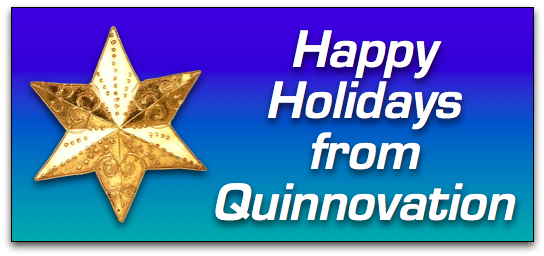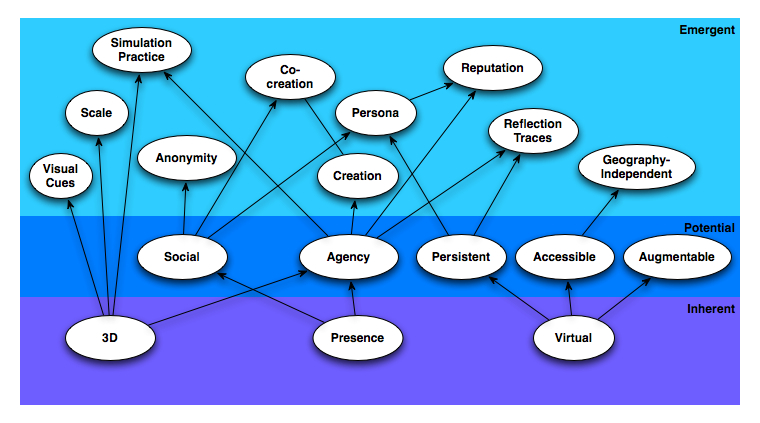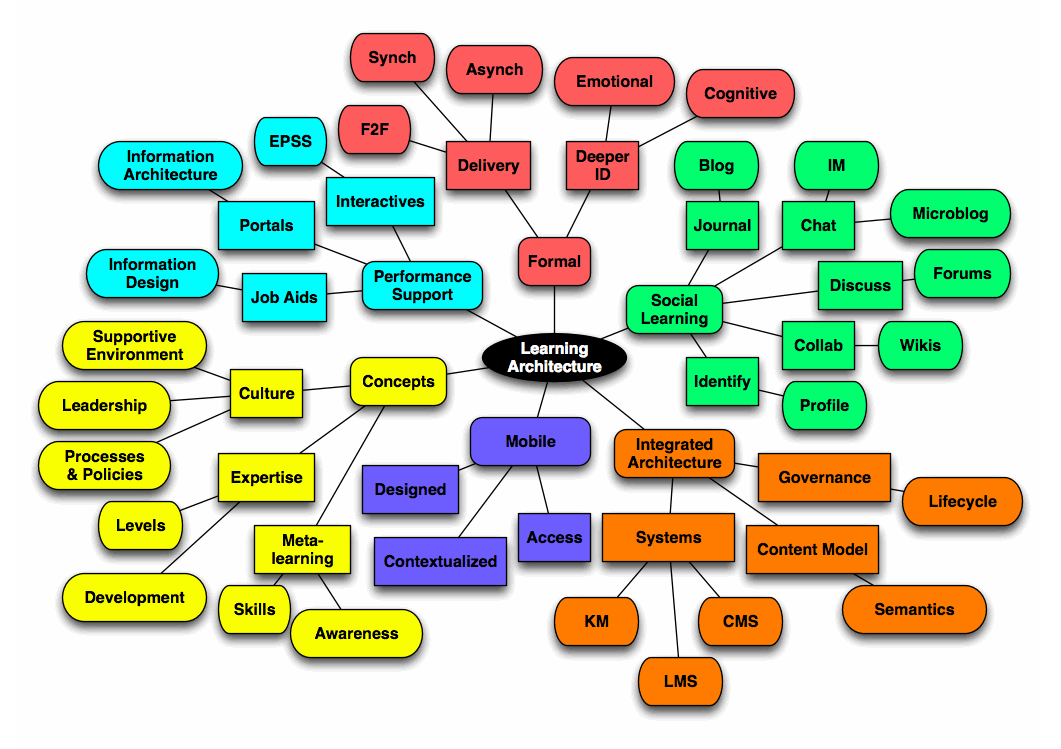The program at the University of Wisconsin-Stout Online Professional Development’s Instructional Design program regularly asks someone to answer a series of questions from their students. I think these sorts of efforts are worthwhile to see a variety of different ideas, and consequently I agreed. Here’re the questions and my answers as presented to the students:
Learning Design Evangelist Clark Quinn Answers Questions
June 2010
1. Are there any critical gaps in knowledge that you frequently encounter in the ID industry?
Clark:
Several: The first is folks who only know the surface level of ID, not understanding the nuances of the components of learning (examples, concepts, etc), and consequently creating ineffective designs without even being aware. This is, of course, not the fault of those who’ve taken formal training, but many designers are transported from face-to-face training without adequate presentation.A related problem is the focus on the ‘event’ model, where learning is a massed event, which we know is one of the least effective mechanisms to lead to long-term retention.
Another gap is a focus on the course, without taking a step back and analyzing whether the performance gap is caused by attitude, motivation or other issues besides skills and knowledge. The Human Performance Technology approach (ala ISPI) is a necessary analysis before ADDIE, but it’s too infrequently seen.
The last is the lack of consideration of the emotional (read: affective and conative) side of instructional design. Most ID only focuses on the cognitive side, and despite the efforts of folks like John Keller, Michael Allen, and Cathy Moore, among others, we’re not seeing sufficient consideration of engagement.
2. In a world where technology changes daily, do you feel we place too much emphasis on the latest and greatest delivery method? Do you foresee a future where higher education is delivered primarily through distance learning?
Clark:
Yes, we do see ‘crushes’ on the latest technology, whereas we should be focusing on looking at the key affordances and matching technologies appropriately to need. I’m a strong proponent of the potential of new technologies to create new opportunities, but very much first focused on the learning outcomes we need to achieve. Which is why I have complicated feelings about the future of higher ed. In a time of increasing change, I think that the new role of higher education will increasingly be to develop the ability to learn. The domain will be a vehicle, but not the end goal. Which could be largely independent of place, but I liked the old role of new and independent mentorship beyond family and community, and always felt that there was a socializing role that university provides. I’m not quite sure how that could play out via technology mediation, but I do note the increasing role of social media.
3. Is there an elearning authoring tool you would endorse?
Clark:
Paper and pencil. Seriously. I wrote many years ago of a design heuristic, the double double P’s: postpone programming, and prefer paper. An associated mantra of mine is “if you get the design right, there are lots of ways to implement it; if you don’t get the design right, it doesn’t matter how you implement it”. Consequently, I prefer the cheapest forms of prototyping, and rapid cycles of iteration, and you can do a lot with post-it notes (e.g. the Pictive technique from interface design).
4. What impact, if any, do you think that the shortened attention span habits dictated by most social media will have on e-learning?
Clark:
I think that you should be very careful about media-manufactured trends. Our wetware hasn’t changed, just our tolerance of certain behaviors. We’ve always had short attention spans, it’s just that our schooling forced us to mask it. We’ve also been quite capable of multi-tasking (ask any single parent), but it does provide a detriment to performance in each task, or cause the task to take longer. (Other seriously misconstrued ideas include digital natives, learning styles, and generational differences).
I think we should look to learning that optimizes what’s known about how we learn (and see Daniel WIllingham for a very apt critique of brain-based learning), which includes smaller chunks over a longer period of time. That’s just one component of a more enlightened learning experience predicated on a longer-term relationship with a learner.
5. Is there current research that shows whether employers view fully online degrees programs any different than a traditional degree program? Do employers care that an applicant may have not attended any face to face classes while earning an advanced degree?
Clark:
Frankly, this is research I haven’t really tracked. I do know recent research shows that online is better than face-to-face, but most likely due to quality of design (instructors aren’t necessarily experts in learning design, sadly) than media.
6. What skills are critical to the survival of a new ID professional? What skills must be focused upon in the first three critical years of business?
Clark:
The skills that are necessary are much more pragmatic than conceptual. While I’d love to say “knowledge of learning theory”, and “enlightened design”, I think in the initial stages proper time/project management will probably pay off more immediately. Also, the ability to know what rules to break and when. That said, I think you absolutely need the domain knowledge, but street smarts are equally valuable.
However, the core one is the ability to learn effectively and efficiently. I argue that the best investment a business could make is not to take learning skills for granted but document them, assess them, and develop them. Personally, I’ll say the same: the best investment you can make is in your ability to learn continuously, eagerly, even joyously.
7. What areas of growth do you see in the ID market?
Clark:
With lots of caveats, because I’m involved in many:
Right now I’m seeing growth in the social learning space. Understanding and taking advantage of social learning is trendy, but offers the potential for real learning outcomes as well. Naturally, the only problem is separating the snake oil from the real value. My involvement in the Internet Time Alliance is indicative of my beliefs of the importance.
I think the whole ‘cloud’/web-based delivery area is seeing some interesting growth too, with everything from rich internet applications to collaborative authoring. The opportunities of web 3.0 and semantic technologies are still a ways off, but I think the time is right to start laying the foundations (caveat, I generally find I’m several years ahead of the market in predicting when the time is ripe).
An area that I’m seeing a small uptick in is engagement, fortunately, the use of games and scenarios. Having a book out on the topic makes it gratifying to see the growth finally taking off.
And mobile is finally taking off! Having just left the first biz-focused mobile learning conference, I was thrilled to see the amount of excitement and progress. (Snake oil disclaimer: I’ve been on the stump for years, and finally have a book coming out on the topic. :)

 Corrie Bergeron (@skydadddy) pointed out that I hadn’t really accounted for the ability to create a persona, a representation of yourself via avatar that reflects how you’d like to be perceived. Chuck Hamilton did have it in his list, and I thought it was implicit in the alternative to anonymity, but on reflection, I think it does deserve it’s own affordance, and implications for reputation.
Corrie Bergeron (@skydadddy) pointed out that I hadn’t really accounted for the ability to create a persona, a representation of yourself via avatar that reflects how you’d like to be perceived. Chuck Hamilton did have it in his list, and I thought it was implicit in the alternative to anonymity, but on reflection, I think it does deserve it’s own affordance, and implications for reputation.